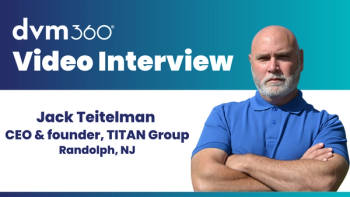
Litigation trepidation: DVMs expres concern about malpractice, liability
A lawyer rarely pursues a lawsuit against a veterinarian who apologizes.
NATIONAL REPORT — A dog presented at Dr. Robert Gordon's practice with toxic overdose hours after ingesting human medication. When it died of liver failure, the owners sued twice, first seeking damages for alleged negligence. The case was thrown out, but the owners later tried gaining compensatory reparation for the value of the dog and its lost litters.
Once again, the lawsuit was turned away.
Dr. Robert Gordon
That was eight years ago, and the legal system still rarely finds grounds for retribution in such cases. But the argument, while void, embodies a growing movement to attach non-economic value to pets in instances of malpractice and wrongful death. The courts have been reluctant to award damages beyond property value, yet veterinarians sit at the crossroads. While practitioners benefit from the human-animal bond's impact on transaction fees, the profession's majority works to suppress those same emotional ties when it comes to lawsuits seeking damages for more than replacement value.
The paradox fails to sit well with many veterinarians. According to DVM Newsmagazine's 2006 State of the Veterinary Profession Survey, 16 percent of the triennial survey's 564 respondents view lawsuits and malpractice threats as the most pressing issue of veterinary medicine (Table 1). Dr. Bill Folger acknowledges there is inequity surrounding a profession that benefits from a bond from which owners rarely recover legitimate malpractice claims. In egregious cases, larger claims might be warranted, but they're still unlikely, he says.
Table 1 About 16 percent of responding veterinarians say malpractice threats and lawsuits are the most pressing issues facing veterinary medicine
"Do I think this is a significant threat to the veterinary profession? No," says Folger, owner of Memorial Cat Hospital in Houston. "But I believe attorneys, just like us, are looking for avenues of revenue enhancement. They believe that if they can get a foothold in the legal profession to establish enhanced value in animals, they'll stand to profit. That's what worries me as a veterinarian."
Taking the issue courtside
Efforts to increase pet value among the nation's courts and state legislatures are measured in dollars. Last month, an Oregon case received international attention when a jury awarded owners $56,400 for its intentional death of a dog after a neighbor ran it over in front of the owners' family. Plaintiffs for the case hoped to break legal ground by seeking $1.6 million in loss of companionship damages. The judge rejected that claim as "not a viable theory under Oregon law" but allowed the jury to consider economic and punitive damages as well as emotional distress claims.
When it comes to intentional torts, emotional distress is not an unusual damage award for all kinds of property, and veterinarians are vulnerable, says Laura Ireland Moore, Esq., founder and executive director, professor of Lewis & Clark's Animal Law Clinic and faculty adviser to the Animal Law Review. The law school offers the most comprehensive animal law curriculum in the country, offering six classes on the topic and churning out roughly 50 students each year. Moore boasts of handling more than three-dozen malpractice cases involving DVMs.
"It's rare, but there are intentional abuse and neglect cases involving veterinarians," she says. "They're held to a higher standard in terms of care. When it comes to veterinary malpractice, most of the time they're negligence cases."
Insurance claims
Increased claims against veterinarians translate to higher malpractice insurance premiums, which currently sit on the low end of the medical spectrum, experts say. Yet statistics illustrating a rise in veterinarian-related malpractice instances are largely anecdotal; concrete numbers are difficult to obtain. The American Veterinary Medical Association's Professional Liability Insurance Trust (PLIT), the nation's largest program offering business, personal and professional liability insurance for practitioners, guards its data closely and failed to provide information concerning malpractice claims by presstime. Still, practitioner policies cost just a few hundred dollars a year, far below the premiums paid by the profession's counterparts in human medicine, according to the American Academy of Family Physicians.
In Nebraska, Dr. Orval Gigstad spends roughly $500 annually on premium PLIT coverage. After 30 years as a mixed animal practitioner, the owner of Arbor Valley Clinic foresees the tide turning on premiums but not to the extent foreshadowed by industry experts.
"I thought years ago malpractice claims would get a lot worse, but they haven't," he says. "On the small animal side, you're dealing with emotional costs, but getting into trouble is easier with large animals. If you mess up with a breeding herd and do some damage, that's a little less difficult to prove."
Insurance also has its limits, Gigstad warns, recalling when a calf broke its neck in the practice's dehorn shoot and died.
"If you're shoot's in working order, there's an inherent risk; insurance won't cover the claim," he says. "So I ended up paying the owner $400 for his calf, and it worked out. He was a good client and continued coming to me with his animals."
Apologies lower risk
That's a perfect example of a veterinarian proactively addressing what could have evolved into a legal nightmare, Moore says.
Animal law cases usually are more expensive than the damages they're able to recover. They also are emotionally and financially trying for clients, she explains.
For that reason, veterinarians can steer clear of malpractice claims by communicating with clients and admitting a mistake when appropriate — actions Moore says might go against recommendations made by insurance carriers.
But a lawyer rarely pursues a lawsuit against a practitioner who apologizes, she contends.
"I've never taken a veterinary malpractice case if the veterinarian is sincere and concedes to wrongdoing," Moore says. "When a veterinarian really recognizes the loss by waiving expenses for treatment, the risk of a lawsuit drops dramatically."
Newsletter
From exam room tips to practice management insights, get trusted veterinary news delivered straight to your inbox—subscribe to dvm360.




